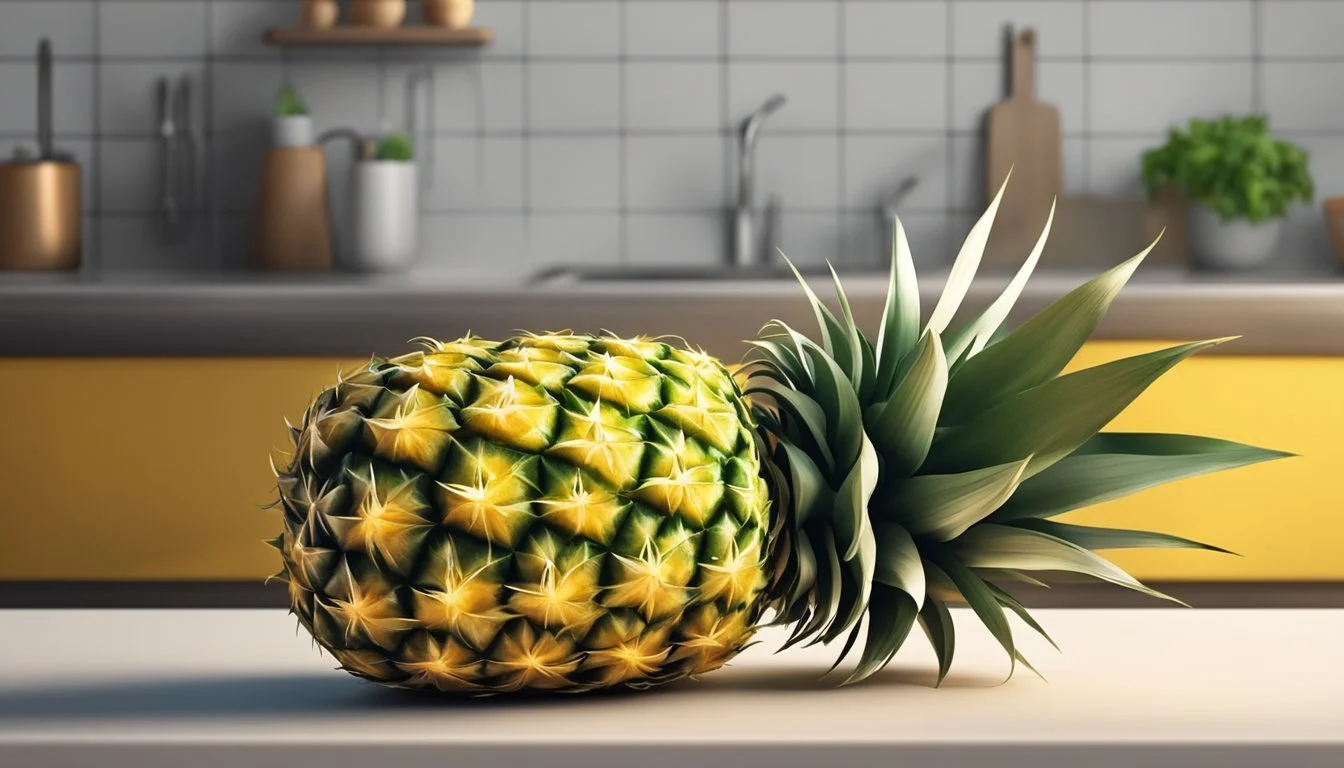How to Tell if a Pineapple is Ripe
Expert Tips for Perfect Selection
Selecting a ripe pineapple can be a tantalizing challenge for both seasoned chefs and home cooks. A perfectly ripe pineapple offers a tropical burst of sweetness and juiciness that is unrivaled by any other fruit. However, understanding the ripeness of this spiky fruit requires a bit more knowledge than simply choosing based on color. It's a sensory experience that engages sight, touch, and smell.
Knowing when a pineapple has reached its peak ripeness can enhance the flavor of a dish, contribute to the nutritional value of your meal, and prevent waste. It's not always about finding the fruit with the golden hue; there are other indicators such as the aroma at the base, the firmness of the shell, and the ease of plucking a leaf from the crown. A ripe pineapple is not just a matter of taste but also a testament to the picker's discernment and understanding of the fruit's subtleties.
Key Takeaways
A ripe pineapple is identified by its sweet aroma, slight softness, and ease of leaf removal.
Properly storing pineapple can maintain its ripeness, and unripe pineapples can be ripened at home.
Using a ripe pineapple enhances the flavor and nutritional value of culinary creations.
Identifying a Ripe Pineapple
When selecting a pineapple, conciseness in assessing its ripeness is key. One should observe the color and appearance, examine its texture and firmness, perform a smell test, and evaluate the ease of plucking a leaf from the crown.
Color and Appearance
A ripe pineapple exhibits a rich, vibrant yellow coloration along its surface, extending from the base upwards. The presence of a greenish-yellow hue is acceptable, but green or gray tones may indicate under-ripeness. An overripe pineapple may have orange tinges. The “eyes,” should be relatively uniform in size and indicate quality.
Texture and Firmness
The optimal texture of a ripe pineapple's skin is slightly firm with a bit of give when pressure is applied. One should gently squeeze the pineapple; it should not be hard, but it shouldn't be overly soft either. The texture should feel consistently firm across the entirety of the fruit.
Smell Test
Ripe pineapples emit a sweet and fruity scent at the base when one sniffs it. The presence of a sweet smell implies that the fruit is ripe. If the scent is alcoholic or vinegary, this suggests over-ripeness and potential fermentation.
Leaf and Frond Test
Gripping a leaf, or frond, from the pineapple's green crown and attempting to pluck it gently can be indicative of ripeness. A leaf that comes out easily suggests the pineapple may be ripe, while leaves that are difficult to remove suggest it is not ready. The remaining green leaves should look healthy, though a couple of dry leaves are not cause for concern.
Stages of Pineapple Ripeness
Determining the ripeness of a pineapple involves assessing its appearance, feel, and smell. The following stages provide a clear understanding of the ripeness levels from underripe to overripe.
Underripe Pineapple
An underripe pineapple typically has a bright green exterior and is quite firm to the touch. It lacks the signature sweetness because the fructose has not fully developed. One can notice that the pineapple feels lighter than it should, indicating that the juiciness is not at its peak. It's important to note that pineapples do not significantly ripen after they are harvested, so waiting for an underripe pineapple to become ripe might be in vain as they don’t produce ethene, a ripening agent.
Perfectly Ripe Pineapple
A perfectly ripe pineapple will exhibit a golden-yellow hue starting at the base and extending up the sides. The fruit should yield slightly under pressure, indicating a juicy texture. It will feel heavy for its size, suggesting that it is full of sweet liquid. The aroma at the base of a ripe pineapple should be sweet and fragrant, without any hints of fermentation or vinegar.
Overripe Pineapple
The signs of an overripe pineapple include a dark yellow to orange skin, and an overly soft, almost mushy texture. The scent may be overly sweet with hints of fermentation or sour vinegar-like odors. The fruit may become slimy and less visually appealing. Taste-wise, the sweetness might have given way to an acidic or fermented quality, making it less pleasant to consume.
How to Ripen Pineapple
When it comes to ripening pineapples, there are several key techniques to employ that encourage the conversion of starches into natural sugars, enhancing the fruit's sweetness and juiciness. The following ripening methods utilize ethylene, a natural plant hormone, to accelerate the process.
Counter Ripening
By simply leaving a pineapple on the counter at room temperature, one can facilitate the ripening process. This method allows the pineapples to slowly ripen over a few days, concentrating the natural sugars. It is important to position the pineapple upside down, balancing it on the leafy crown. This helps redistribute sugars evenly throughout the fruit.
Steps:
Place the unripe pineapple on the counter.
Invert the pineapple, standing it on the leafy top.
Check daily for signs of the outer skin turning more yellow indicating ripeness.
Speeding Up Ripening
To expedite ripening, a pineapple can be placed in an airtight container or a paper bag along with ethylene-producing fruits like apples, bananas, or tomatoes. These fruits emit ethylene gas, which creates a concentrated environment to prompt the pineapple to ripen faster.
Instructions:
Place the pineapple in a paper bag.
Add a banana, apple, or tomato to the bag.
Fold the bag closed to trap the ethylene gas inside.
Leave the bag at room temperature for a day or two checking for the softening of the pineapple and a sweet aroma indicating increased ripeness.
Note: After ripening, pineapples can be stored in the refrigerator to slow down the process and preserve them for longer.
Storing Ripe Pineapples
Once a pineapple is ripe, proper storage is crucial to preserve its freshness and flavor. The refrigerator and freezer offer two effective methods for extending the life of this tropical fruit.
Refrigeration
To store a ripe pineapple in the refrigerator, one should first remove any excess foliage to minimize space. The pineapple can then be placed inside a plastic bag to prevent it from absorbing other flavors in the fridge. It's best to store the fruit in the crisper drawer to maintain optimal humidity. A ripe pineapple typically stays fresh in the refrigerator for up to three to five days.
Steps for Refrigeration:
Remove unnecessary leaves.
Wrap pineapple in plastic wrap or place in a plastic bag.
Store in the crisper drawer for 3-5 days.
Freezing for Later Use
For longer preservation, freezing a ripe pineapple is a viable option. The fruit should be peeled, cored, and cut into chunks or slices first. Then, one can arrange the pieces on a baking sheet lined with wax paper, making sure they do not touch, and freeze until solid. Once frozen, transfer the pineapple to an airtight container or ziplock bag, label with the current date, and store in the freezer. Frozen pineapple is best used within six months for optimal taste and texture.
Steps for Freezing:
Prepare the pineapple by peeling, coring, and cutting into pieces.
Freeze pieces on a baking sheet, then transfer to a labeled airtight container.
Store in the freezer for up to six months.
Preparation and Usage Tips
A ripe pineapple enhances a variety of dishes with its sweet, tropical flavor. This section offers practical advice on preparing this fruit and incorporating it into cooking.
How to Cut a Pineapple
To cut a pineapple, one needs a sharp knife and a cutting board. Follow these steps:
Remove the top and bottom: Slice off the crown and the base to create a stable surface.
Stand it upright: Position the pineapple on its base.
Skin removal: Carefully slice down the sides, removing the skin and eyes.
Cut the flesh: Quarter the pineapple lengthwise and remove the core. Then slice or cube the flesh as needed.
Cooking Tips
Pineapple can be utilized in various culinary applications. Here are specific approaches one can take:
Grilled Pineapple: Brush slices with oil and grill them for 2-3 minutes per side until they exhibit grill marks.
Pineapple Salsa: Combine diced pineapple with onion, cilantro, jalapeños, and lime juice for a zesty salsa.
Smoothies: Blend chunks of pineapple with other fruits and yogurt or juice for a refreshing smoothie.
Sweeten Dishes: Add pineapple to savory dishes to introduce a sweet element.
Pineapple Upside-Down Cake: Use slices to create the iconic bottom layer that becomes the top once inverted.
When one cooks with pineapple, its natural sugars caramelize, enhancing the flavor complexity of the dish, whether it's grilled or baked.
Conclusion
Selecting a ripe pineapple requires attention to detail. Look for golden-yellow skin as a primary indicator. A ripe pineapple should emit a sweet aroma from its base, suggesting readiness for consumption.
One can gently tug on a leaf from the top; if it comes out with ease, the pineapple is likely ripe. Yet, the exterior shouldn't be solely relied upon. Firmness with a slight give upon touch also signifies ripeness, while a too soft texture may indicate overripeness.
A table to simplify the assessment:
Color: Golden-yellow, not entirely green
Fronds: Comes off easily
Aroma: Sweet smell at the base
Firmness: Firm with slight give
External Eye Uniformity: Evenly sized "eyes" or patterns
Choosing a ripe pineapple enhances the eating experience. The next time shoppers navigate through the fruit aisle, these pointers will assist them in picking a fruit that's ready to slice and enjoy.



